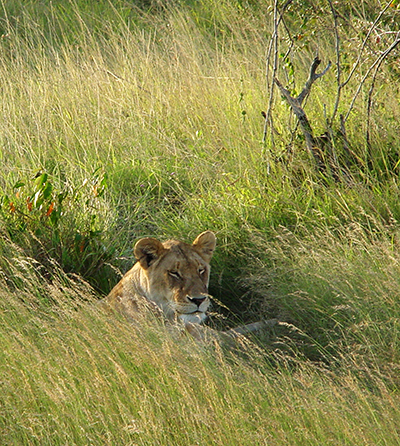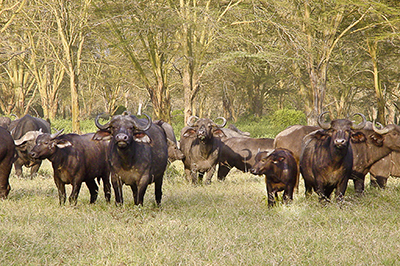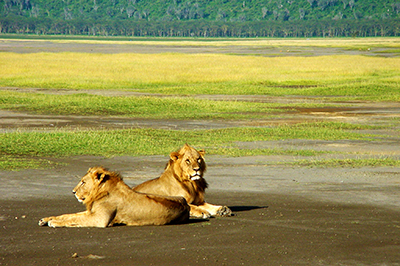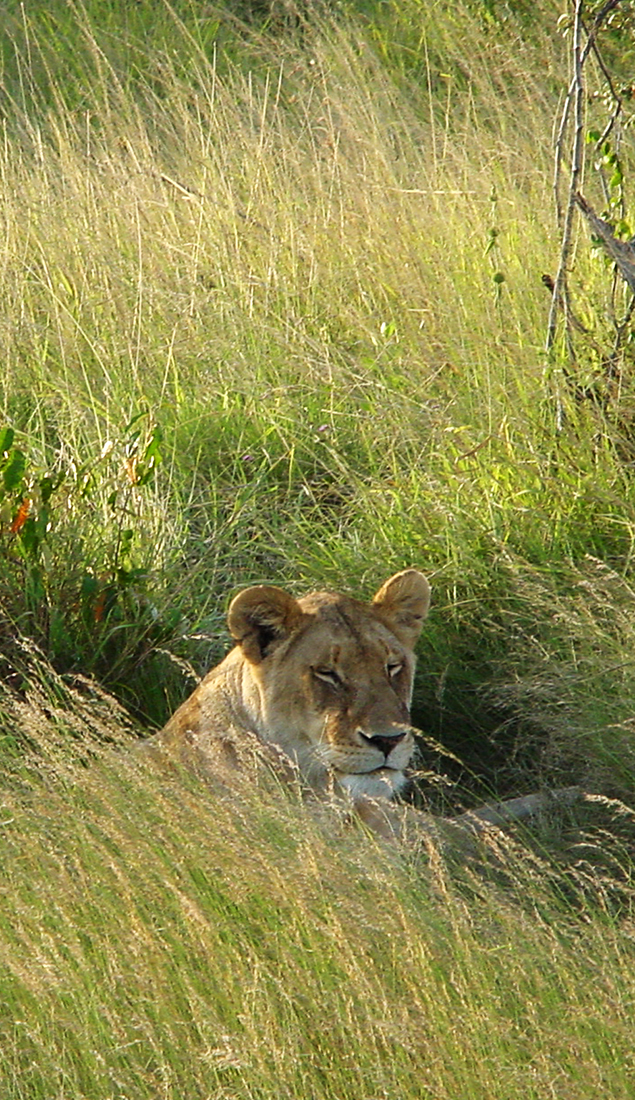 THE FIRST TIME I tracked lions, it was from the relative safety and comfort of a large — although open-topped — Land Rover, with a loaded rifle situated handily next to the driver. At that time our guide had assured us that as long as we didn’t wear brightly colored clothes, make noise or stand up, the animals would perceive us as part of the vehicle, and therefore not worth eating. His logic was not entirely convincing. Lions have been making their living — for, what, several million years? — by figuring out what is, or is not, edible. And we were going to fool them by sitting instead of standing? I was sure the big cats were smarter than that.
THE FIRST TIME I tracked lions, it was from the relative safety and comfort of a large — although open-topped — Land Rover, with a loaded rifle situated handily next to the driver. At that time our guide had assured us that as long as we didn’t wear brightly colored clothes, make noise or stand up, the animals would perceive us as part of the vehicle, and therefore not worth eating. His logic was not entirely convincing. Lions have been making their living — for, what, several million years? — by figuring out what is, or is not, edible. And we were going to fool them by sitting instead of standing? I was sure the big cats were smarter than that.
But this safari was different. We were going on foot, and the strict policy at Camp Okavango was no guns. Big cats, no guns, traveling on foot — hmmm. Why was I doing this?
Adding to my trepidation, our guides, Rodgers and Robert, explained that if we saw lions this morning they would be hungry, because big cats usually hunt at night. If they were still out stalking prey in the morning, it meant they hadn’t found anything to eat the night before. A crazy thought wriggled into my mind: the guides were using us as lion bait. They thought we were clueless American tourists, foolish enough to follow them deep into the big cats’ territory with no means of protection. We were. And we did.
Our guides’ plan was to travel from our camp — located on remote Nxaragha Island in Botswana — by motorboat through the vast Okavango Delta to another island, and from there to proceed on foot in search of the big cats. Many miles out, through the winding, papyruslined waterways, Robert announced excitedly that he had spotted dust in the trees. I didn’t see it, even with my binoculars. And I didn’t understand what dust had to do with lions. But I went along with the program. We anchored the boat, disembarked, and walked into the remote island’s open forest.
This was no Sunday stroll: the tall brown grasses hid treacherous obstacles. Elephants had eaten the relatively tender bark and roots of trees, leaving dead branches and uprooted stumps scattered everywhere. Aardvarks had dug large holes in the ground. Thorns caught on our clothing, and greedy vines grabbed at our legs. And the dung. Everywhere we had to step over dung — all kinds of it, large and small, round and elongated, fresh and dry, in varying stages of decomposition.
I could tell the difference between rhino middens and elephant dung, and I was learning to differentiate buffalo from giraffe. Then I saw a new kind of dung: smaller, rounder, fresher — glistening, in fact. Was it lions’? I wondered just how far away the lions actually were, and how close we intended to get. Checking my field guide, I found that lion droppings “are similar to that of the leopard, but larger.” This was only marginally more helpful than the entry for elephants, which read, “A good way of testing the freshness of dung is to thrust your hand into the center of it. If the dung is fresh, it will be warm inside.”
We were a noisy bunch of Americans, and Rodgers admonished us to “do shhh” and to “talk silently.” I noticed that Rodgers and Robert did indeed talk silently, communicating with their eyes and hands that they had heard a noise in this direction, or that they wanted us to walk that way. They reminded me of a TV SWAT team, moving swiftly and efficiently through the bad guy’s hideout just before the big shoot-down. Our group, on the other hand, moved like a bunch of Keystone Cops, zigzagging randomly, tripping in the aardvark holes, backtracking around fallen trees and fighting back with all our might when vicious vines attacked.
Robert reminded us to walk in single file, always staying together. If we fell back or got out of line, he warned, we’d look smaller and be “on the menu.” As if lions haven’t had plenty of experience in picking individuals out of a herd. As if they would look hungrily at a line of humans hiking single file and think, that’s just some giant, nastytasting caterpillar, seriously overburdened with indigestible cameras and binoculars, stumbling slowly and vulnerably through my sovereign territory. Forget it — no chow there.
Most important, Robert said, if a lion did come toward us, “Don’t run! Stand your ground!”
Stand my ground?
 In the face of a charging lion? What kind of instruction was that? My heart pounded at the thought of it; my legs stiffened, and I wondered whether it would be a good thing to be frozen with fear. My hands began to sweat, and I remembered reading somewhere that humans, dogs and other mammals whose paws sweat with anxiety do so because the sweat increases friction between the paws and a substrate, allowing for quicker getaways. I was built to run then, not to stand my ground.
In the face of a charging lion? What kind of instruction was that? My heart pounded at the thought of it; my legs stiffened, and I wondered whether it would be a good thing to be frozen with fear. My hands began to sweat, and I remembered reading somewhere that humans, dogs and other mammals whose paws sweat with anxiety do so because the sweat increases friction between the paws and a substrate, allowing for quicker getaways. I was built to run then, not to stand my ground.
I stayed near the front of the line, just behind Maureen, a psychiatric nurse from Pittsburgh. Maureen walked with her shoulders slightly hunched, took each step slowly and deliberately, and shaded her eyes from the sun as she scanned the distance. I thought she looked like a professional tracker, except for her bright white Asics Gel running shoes — obviously bought new for the trip — and hot pink windbreaker. I had chosen my place carefully: surely the hot-pink-windbreaker variety of meal would be most tempting. If a lion charged, I would simply maintain my position behind the primary bait.
Maureen’s left shoelace was untied. Should I tell her? If I did, she’d stop to tie it, and the whole single-file line would crash into us like a row of dominoes. I would be trampled by my fellow travelers, and perhaps sprain my ankle or fall into a pile of warm dung in the process. If I didn’t, Maureen might trip and fall, and be eaten alive.
I kept my mouth shut.
A large, lone bird circled the sky above us. Robert identified it as a white-backed vulture (Gypus africanus). Our guides had amazing eyesight. Born and raised in the delta, they could identify all the birds and animals from far away. Soon a second vulture appeared, and then a third. Apparently the vultures knew something we did not.
As we hiked deeper into the forest — way too far in to run for the boat — Robert still saw dust. We kept walking, single file, assiduously staying together, not falling back or getting out of line, doing shhh, going deeper into the forest.
At one point I was tempted to stop and photograph a little bee-eater (Merops pusillus), a brilliantly colored bird with an emerald back, golden throat and brilliant blue “eyebrow.” Bee-eaters feast on bees, wasps and hornets, removing the stingers first by repeatedly hitting the captured insect on a hard surface. These exquisite beauties often make their homes in excavated dirt at the entrance to an aardvark den, and I wanted to stop and hunt for nests. But when I considered the possibility of death by lion, I decided to stay with the group.
“Listen!” Rodgers and Robert both heard the lions.
We kept walking. At first we didn’t hear anything, but a ways farther in we heard a low rumbling sound. “It’s the lions! Yes, and they are chasing buffalo!” The rumbling, our guides explained excitedly, was the sound of a thousand hooves. We proceeded, still in line, straining to get a look through the trees at a buffalo or a lion. Suddenly Robert hurried back into our midst, eyes wide and round, and bulging so the whites showed around their whole circumference. “They are coming this way!” he shouted hoarsely.
“We are too close! Go back! Go back!”
Finally I saw the dust, a huge cloud of it, about 200 yards away and coming toward us fast. It was swirling above a herd of several hundred cape buffalo, and they were coming toward us fast, too. Stampeding, actually.
We had been told to stand our ground in the face of a charging lion, but what was the protocol for a buffalo attack? There was no time to ask. Our careful, single-file line disintegrated into chaos as we ran back — hats, cameras and binoculars flying. No more zigzagging to avoid holes or backtracking around fallen trees; we leapt them all heroically. Several of our group turned out to be talented sprinters, and I personally tested the freshness of five or six piles of dung in the space of 20 seconds.
As suddenly as the stampede began, it was over. It’s interesting, what goes through one’s mind at a time like this. As soon as “Escape! Escape!” had run its course, I was overwhelmed with the perfection of Nature’s Grand Plan: elephants knock down large trees, allowing grasslands to develop, which attracts grazing animals, which provide food for the lions. The aardvark holes create natural traps for the lions’ prey; the monumental, nutrient-rich elephant droppings fertilize the tall grasses…
Lost as I was in the beauty of the Grand Plan, it was several minutes before I remembered Maureen. How did her untied shoelace fit in? Had I been homicidally remiss in not mentioning it earlier? Or was I simply playing my predetermined part in the survival of the fittest? Did Maureen stand, or did she run? Had she been trampled by stampeding buffalo, or even eaten by a hungry lion?
 I came to my senses, surveyed the scene, and saw Maureen’s hot pink jacket halfway up a small tree, with Maureen still inside it. Apparently it had not provoked the lions. We began to regroup, and everyone seemed to have survived. The cape buffalo — still about 70 yards away — had also survived. They had all stopped running and were now milling about restlessly. They seemed to be more afraid of us than of the charging lions. This did not strike me as an effective adaptive behavior, but what do I know about the life of a buffalo? And what did they know about humans? At any rate, they kept their eyes on both us and the lions, which — conveniently — made it easy for us to observe the five adult lions that were now in our immediate vicinity.
I came to my senses, surveyed the scene, and saw Maureen’s hot pink jacket halfway up a small tree, with Maureen still inside it. Apparently it had not provoked the lions. We began to regroup, and everyone seemed to have survived. The cape buffalo — still about 70 yards away — had also survived. They had all stopped running and were now milling about restlessly. They seemed to be more afraid of us than of the charging lions. This did not strike me as an effective adaptive behavior, but what do I know about the life of a buffalo? And what did they know about humans? At any rate, they kept their eyes on both us and the lions, which — conveniently — made it easy for us to observe the five adult lions that were now in our immediate vicinity.
Make that five hungry adult lions.
I had heard that female lions form hunting bands, and that the males don’t bother to assist them. But this was a group of four females and one large male with an impressive golden mane. What was he doing there? He was probably so famished that he couldn’t even wait for the females to make a kill. He was big, that was for sure. I couldn’t see his teeth, but I know they were long and sharp, and I’ll bet he was salivating.
I smelled the dust. Dust, and a sweat-like smell. Was it the buffalo, or the lions? Was it me? Was it fear? The lions were not yet attacking, so I had a moment to contemplate: should I turn and run, or stand and scream? Would it make a difference? Did I have a choice? I would like to report that Rodgers and Robert were unfazed, but that would not be entirely true. Actually, they looked anxious. They had no guns. They were responsible for a dozen travelers. And we were 70 yards away from five hungry lions.
The big cats paced around the edges of the buffalo herd, eyeing one individual, then another. What if one looked at me? Should I make eye contact, or avoid it? I began to feel panicky. Robert’s words echoed in my mind: if a lion does come toward you, don’t run. Legs locked, I stood my ground, and felt proud of myself for having the presence of mind to follow instructions in a crisis. But then it occurred to me: if I stood my ground, and everyone else retreated, did that make me clever? Or did it make me lion food?
Fortunately, my survival did not depend on my own cleverness: Rodgers and Robert took control, instructing us to remain facing the lions and walk slowly backward, away from them. We did so. Soon, it was safe to turn and walk — a bit more quickly — back to the boat. When we were safely on board, and motoring back to camp, I marveled at the beauty of Nature’s Grand Plan, at green papyrus against intense blue skies and the deliciousness of a bottle of cold Chibuku Shake-Shake beer.
Life is good, when you’re not on the menu.
About the Book
This article was excerpted from Laurie McAndish King’s travel memoir Lost, Kidnapped, Eaten Alive! True Stories from a Curious Traveler (Destination Insights, 259 pages).


